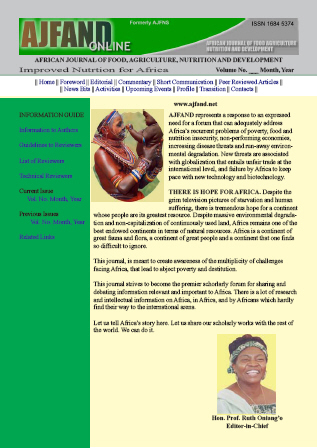
|
African Journal of Food, Agriculture, Nutrition and Development
Rural Outreach Program
ISSN: 1684-5358
EISSN: 1684-5358
Vol. 18, No. 1, 2018, pp. 13110-13128
|
 Bioline Code: nd18018
Bioline Code: nd18018
Full paper language: English
Document type: Research Article
Document available free of charge
|
|
|
African Journal of Food, Agriculture, Nutrition and Development, Vol. 18, No. 1, 2018, pp. 13110-13128
| en |
DIETARY DIVERSITY AMONG SMALLHOLDER HOUSEHOLDS IN BUKOBA DISTRICT, TANZANIA AND KIBOGA DISTRICT, UGANDA
Nabuuma, D; Ekesa, B & Kennedy, G
Abstract
Undernutrition in developing countries continues to affect 780 million people resulting
in poor growth and development; increasing the burden of disease and imposing a
number of costs on the affected countries. The aim of this study was to establish the
dietary diversity and consumption patterns among small-holder farming households. A
cross-sectional study was carried out in Kiboga district, Uganda and Bukoba district,
Tanzania with 220 and 199 households, respectively. Results from the 24 hour recall
showed that white roots, tubers and bananas were the most consumed food group in the
two districts with a significantly higher consumption in Kiboga than Bukoba. However,
households in Bukoba had higher dietary diversity scores compared to those in Kiboga
even though both districts had 52% of the households consuming diets with moderate
dietary diversity. The percentage of households consuming vitamin A rich vegetables
and fruits, and animal protein (flesh meats, organ meats and eggs) was negligible. There
was no significant difference between food group consumption at household level and
that of the youngest 6-59 month-old child within these households. High consumption of
a food group and absence of a food group by the whole household was matched by the
consumption of the children. Only 48% and 35% of caregivers in Kiboga and Bukoba,
respectively reported preparing special meals for the child. Younger caregivers, ability
of households to rent out land, and distance to market were variables that significantly
influenced intake of vitamin A and iron but not protein. The results highlight
opportunities for the promotion of vitamin A- rich fruits and vegetables, and protein
foods in between the main household meals of the day, as well as avenues through which
nutrition education can be reinforced to improve the knowledge and skills of the
households, especially the decision makers and care givers of children under five years
of age.
Keywords
Dietary diversity; Food groups; Household consumption; Smallholder; Vitamin A; Protein
|
| |
© Copyright 2018 - African Journal of Food, Agriculture, Nutrition and Development
Alternative site location: http://www.ajfand.net/
|
|
